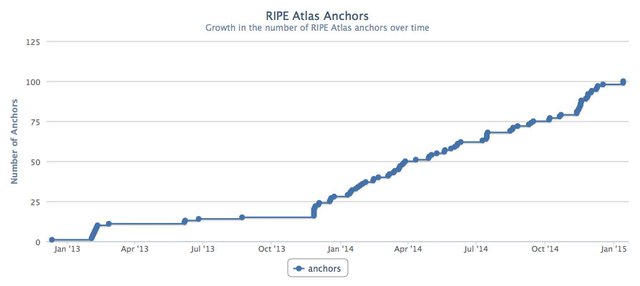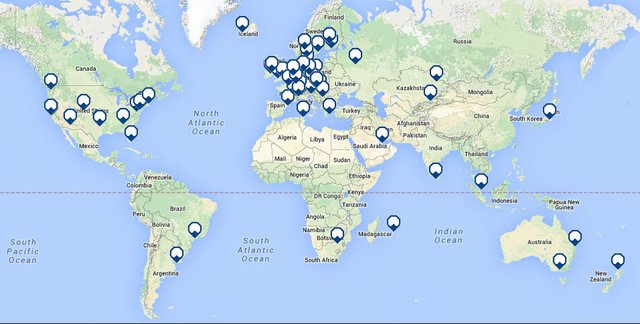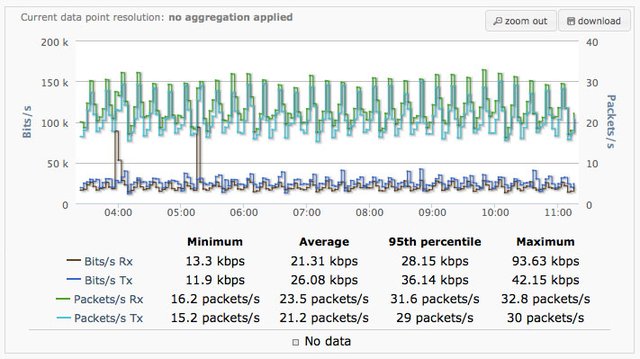We're pleased to announce a major milestone in the RIPE Atlas anchors project: the 100th anchor is now online!
Since launching RIPE Atlas anchors at the RIPE 67 Meeting in October 2013, we've worked hard to grow the network and distribute anchors as widely as possible - and we couldn't have done it without the dedication of our community of anchor hosts . The honour of being the 100th RIPE Atlas anchor goes to DK Hostmaster A/S in Ballerup, Denmark.
Now that we've reached 100 anchors, the RIPE Atlas network is more robust than ever. If you're interested in the latest stats and measurements, or need some ideas about how you can make use of anchoring measurements, keep reading!

Latest Stats
The RIPE Atlas anchors network continues to expand and is becoming truly global. Of the 100 anchors now online:
- The US boasts the biggest number of anchors than any other country, with a total of 18
- There are now 8 anchors in the southern hemisphere, including in Uruguay, Brazil, South Africa, Mauritius, Sri Lanka, Australia and New Zealand
- 10 out of 15 RIS locations host an anchor
- 10 out of 13 K-root locations host an anchor
- All five RIRs now host a RIPE Atlas anchor

We also want to give a shout out to the two fastest anchor hosts, who got their anchors online from start to finish in a matter of just a couple of days: Tim Kleefass at BelWü in Germany, and Jan Žorž at Go6 Institute (sponsored by SIDN) in Slovenia. Nice job!
Bandwidth
When it comes to determining how much bandwidth RIPE Atlas anchors use, there are really two answers: the amount currently being used, which is dependent on the current number of active anchors, and the amount needed for expected growth.
Currently, anchors that are involved in DNSMON measurements use about 256 Kb/s of bandwidth, whereas anchors that don't perform DNSMON measurements use about 50 Kb/s.
However, when recruiting new anchor hosts, we ask them to be prepared for up to 10 Mb/s of bandwidth to allow for future growth, because anchors perform mesh measurements between one another, and because the number of regional measurements targeting each anchor grows with the number of regular probes.
We understand that this commitment may be easier or more difficult to meet depending on where anchors are located. If you are interested in hosting an anchor but have concerns about the bandwidth needed, please get in touch with us.

Use Cases
We've already heard from some anchor hosts about how useful the anchor has been not only for the RIPE Atlas network, but for their own needs.
For example, Tim Kleefass, an engineer at BelWü (an academic network in Germany), wrote a nice RIPE Labs article about how they used their newly installed anchor to debug network issues and test the performance of a new middleman ISP they were using between their network and a university network.
For more use cases, personal experiences, analyses and scientific papers using RIPE Atlas data, take a look at the RIPE Atlas User Experiences collection on RIPE Labs.
Measurements
We've made some recent changes to the way we conduct anchoring measurements.
First, we've increased the number of probes regularly measuring each anchor from 300 to 400 as the RIPE Atlas network has continued to grow, in order to provide better data resolution.
Second, we've started running regular calibration measurements from all the probes in the RIPE Atlas network to the anchors in order to test their IPv4 and IPv6 connectivity. Monitoring the health of the network on this regional level provides us with the reachability history for all of the anchors. We're going to make more information available about these measurements in the coming weeks - stay tuned!
Third, many anchors are now performing DNSMON measurements. The DNSMON service was transitioned into RIPE Atlas in mid-2014 and is now available via the RIPE Atlas website .
Finally, there are plans to enable HTTP measurements towards RIPE Atlas anchors. To take part in the ongoing discussion, please read the proposal on the MAT Working Group Mailing List .
Host or Sponsor an Anchor
Interested in hosting an anchor yourself? Learn more about the benefits and requirements.
It's also possible to sponsor an anchor that another organisation is interested in hosting. We have a list of organisations that are willing to supply the bandwidth and maintenance necessary in hosting an anchor, but can't afford to pay for the hardware. Please get in touch with us at atlas [at] ripe [dot] net for more details.
As part of our partnership with the other RIRs, APNIC will be hosting 10 anchors on behalf of the RIPE NCC and has already deployed two of these, with another two in the pipeline. We're very grateful for their support in this region, as well as to the other RIRs for their support. We hope to expand on these partnerships in the future.
Future Plans
Even though we've now reached 100 anchors, our job is far from done! There are many other organisations that have expressed interest in becoming an anchor host and are partway through the process, so we expect the network to continue to grow in the coming months.
By the end of 2015, we'd like to grow the RIPE Atlas anchors network to include 150 anchors in diverse locations, both geographically and topologically speaking, in order to provide the best possible coverage in terms of regional connectivity measurement data.
You can find more detailed plans on the RIPE Atlas Roadmap .
Feedback
What do you think about RIPE Atlas anchors and our future plans? How have anchors helped your organisation or network? Do you know someone who might be interested in hosting an anchor in an under-represented region of the world? We want to hear from you!
- For specific questions about RIPE Atlas, including RIPE Atlas anchors, please use the RIPE Atlas mailing list for active RIPE Atlas hosts and interested users, which is also followed and answered by RIPE Atlas developers: ripe-atlas [at] ripe [dot] net
- For more general discussions about measurements and future plans, please use the Measurements Analysis and Tools Working Group Mailing List: mat-wg [at] ripe [dot] net
- Join the discussion on Twitter: @RIPE_Atlas





Comments 0
The comments section is closed for articles published more than a year ago. If you'd like to inform us of any issues, please contact us.